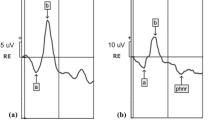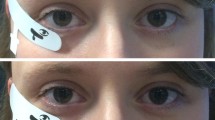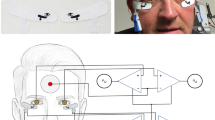Abstract
Purpose: Compare elctroretinogram(ERG) responses to full-field stimuli recorded with corneal-contact and skin electrodes in healthy children and adults. Method: ERGs were recorded independently in two laboratories in children (aged 4–14 years) and adults (aged 20–62 years). A Burian–Allen (BA) electrode were used to test both children and adults in one laboratory. A Gold Foil (GF) electrode was used to test adults and skin electrodes to test children and adults in the other laboratory. Responses were recorded to full-field stimuli similar to those specified in the ISCEV Standard. Dark-adapted responses were also recorded over a 5 log unit range of stimulus energies. Results: All ISCEV rod and cone responses were recorded in every subject with skin electrodes as well as with eye-contact electrodes. BA and GF amplitudes and latencies were similar for the majority of ISCEV responses. The waveform morphology of rod and cone skin electrode responses was similar to corneal electrode responses in children and adults. GF electrode responses were on average 4 to 5 times larger than skin electrode responses recorded in the same laboratory. After scaling skin electrode responses by 4.5 the distribution of response amplitudes was found to be similar to that for the eye-contact electrodes in both children and adults. Dark-adapted responses were recorded to all stimulus intensities in every subject with each type of electrode. B-wave S-R functions were evaluated by fitting the Naka-Rushton equation. Vmax was similar for BA and GF electrode responses and this was about 4 times greater than for skin electrode responses. Log Sigma was similar for GF and skin electrodes but these differed significantly from the BA electrode. Vmax and log(sigma) were similar in adults and children for BA and skin electrode responses. Conclusion: ERGs to full-field stimuli can be recorded successfully with either eye-contact or skin electrodes.
Similar content being viewed by others
References
Marmor MF, Zrenner E. Standard for clinical electroret-inography (1999 update). Doc Ophthalmol 1998/1999; 97: 143–56.
Fulton AB, Hansen RM, Westall CA. The ISCEV rod, maximal and cone responses in normal subjects. Doc Ophthalmol 2003; 107: 235–41.
Wongpichedchai S, Hansen RM, Koka B, Gudas VM, Fulton AB. Effects of halothane on children 's electrore-tinograms. Ophthalmology 1992; 99: 1309–12.
Westall CA, Panton CM, Levin AV. Time course for maturation of electroretinogram responses from infancy to adulthood: ERG responses mature at different ages. Doc Ophthalmol 1999; 96: 355–79.
Chaudhary V, Hansen RM, Lindgren H, Fulton AB. Effects of telazol and nembutal on retinal responses. Doc Ophthalmol 2003; 107: 45–51.
Tremblay F, Parkinson JE. Alteration of electroretino-graphic recordings when performed under sedation or halogen anesthesia in a pediatric population. Doc Oph-thalmol 2003; 107: 271–9.
Fulton AB, Hartmann EE, Hansen RM. Electrophysio-logic testing techniques for children. Doc Ophthalmol 1989; 71: 341–54.
Harden A. Non-corneal electroretinogram: parameters in normal children. Br J Ophthalmol 1974; 58: 811.
Harden A, Picton-Robinson N, Bradshaw K, Pampigli-one G. Ten years experience of ERG/VEP/EEG studies in visual disorders in paediatrics. In: Barber C. (ed. ) Evoked potentials. MTP Press, 1980.
Kriss A, Russell-Eggitt I. Electrophysiological assess-ment of visual pathway function in infants. Eye 1992; 6: 145–53.
Kriss A. Skin ERGs: their effectiveness in paediatric visual assessment confounding factors, and comparison with ERGs recorded using various types of corneal elec-trode. Int J Psychophysiol 1994; 16: 137–46.
Shawkat FS, Kriss A, Russell-Eggitt I, Taylor D, Harris C. Diagnosing children presenting with asymmet-ric pendular nystagmus. Dev Med Child Neurol 2001; 43: 622–7.
Stirn-Kranjc B, Brecelj J. Electrophysiology as a diag-nostic aid in pediatric ophthalmology. Zdravniski vesnik 1993; 62: 91–99.
Armington JC. The electroretinogram. Academic Press, 1974.
Berry H. Clinical electroretinography by the skin elec-trode and signal averaging method. Can J Ophthalmol 1976; 11: 160–64.
Mustonen E, Sulg I. Electroretinography by skin elec-trodes and signal averaging method. Acta Ophthalmol 1980; 58: 388–96
Giltrow-Tyler Crews SJ, Drasdo N. Electroretinography with noncorneal and corneal electrodes. Invest Ophthal-mol Vis Sci 1978; 17: 1124–27.
Esakowitz L, Kriss A, Shawkat F. A comparison of. ash ERGs recorded from Burian –Allen, JET, C-glide, Gold Foil, DTL and skin electrodes. Eye 1993; 7: 169–71.
Marmor MF, Arden GB, Nilsson SE, Zrenner E. Stan-dard for clinical electroretinography. Arch Ophthalmol 1989; 107: 16–19.
Conover WJ. Practical nonparametric statistics. Wiley, New York, 1999; 300–2.
Wali N, Leguire LE. Dark-adapted luminance-response functions with skin and corneal electrodes. Doc Ophthal-mol 1991; 76: 367–75.
Hennessy PM, Vaegan. Amplitude scaling relationships of Buria –Allen, gold foil and Dawson Trick and Litzkow electrodes. Doc Ophthalmol 1995; 89: 235–48.
Fulton AB, Hansen RM. Electroretinography: applica-tion to clinical studies of infants. J Pediatr Ophthalmol Strabismus 1985; 22: 251–5.
Breton ME, Quinn GE, Schuller AW. Development of electroretinogram and rod phototransduction responses in human infants. Invest Ophthalmol Vis Sci 1995; 36: 1588–603.
Fulton AB, Hansen RM. The development of scotopic sensitivity. Invest Ophthalmol Vis Sci 2000; 41: 1588–96.
Cringle SJ, Alder VA, Brown MJ, Yu DY. Effect of scleral recording location on ERG amplitude. Curr Eye Res 1986; 5: 959–65.
Fulton AB, Hansen RM. Stimulus/response functions for the scotopic b-wave. In: Heckenlively JR, Arden GB, eds. Principles and practice of clinical electrophysiology of vision. Moser, 2004.
Author information
Authors and Affiliations
Rights and permissions
About this article
Cite this article
Bradshaw, K., Hansen, R. & Fulton, A. Comparison of ERGs recorded with skin and corneal-contact electrodes in normal children and adults. Doc Ophthalmol 109, 43–55 (2004). https://doi.org/10.1007/s10633-004-1751-3
Issue Date:
DOI: https://doi.org/10.1007/s10633-004-1751-3




